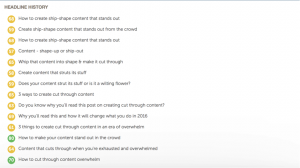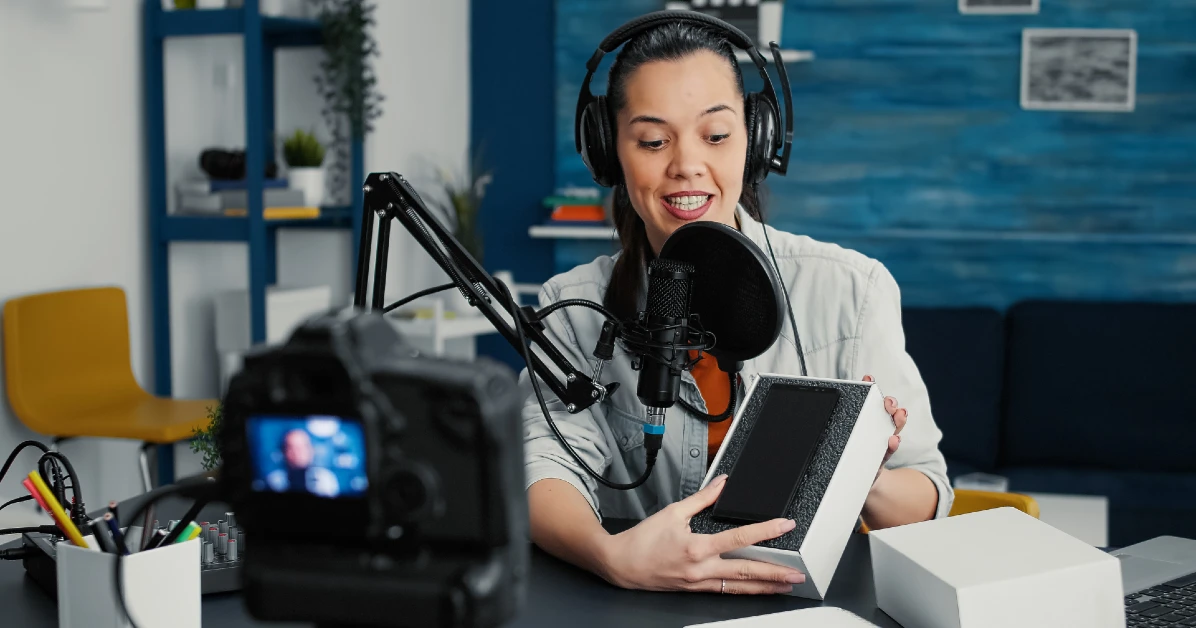This post will have its hand up today with 2 million others and 27 million pieces of content yelling ‘pick me’.
Enormous figures and they’re growing. According to Mark Schaeffer, the amount of web-based content we consume is doubling every 9 to 24 months so if you’re feeling overwhelmed, fasten your seatbelt.
There’s so much information out there that people feel they can’t keep up, and they can’t but here’s the good news – it’s not important. What’s important is standing out.
This is how.
Be acutely relevant
I won’t read The critical changes to Australian tax law in 2015 that will impact preparation of tax returns but my accountant will.
In other words, what you have to say matters to those who want to hear it.
You’re not really up against 27 million pieces of content, but you ARE competing for attention with those saying similar things (collaborators and competitors) and the multiple other, often conflicting priorities a person has to juggle every 24 hours.
To cut through all this, you must know the person you want to reach inside out and be acutely relevant.
There are thousands of posts on how to identify your audience, to really get under their skin. This is detailed work. It’s a lot more than saying you want to reach mothers or marketers. Which ones? Who are they? Where are they? How do they want to hear from you? What language, tone? What stops them in their tracks? What’s their medium? Is it it a Reader on the tram? A podcast on the treadmill?
Do that work. Your ‘audience’ will suddenly transform into someone you know and that changes everything.
How these 3 part-time marketers use Freelancer to earn $350 extra week in just two hours, after hours.
Is that really Jane, the mid-tier marketing professional who’s balancing work, young kids and a mortgage you’re talking to? I think it is. Did she read it? You bet.
Fall in love with the people you serve. Don’t even call them an audience, I hate that term (although it’s useful). They’re your sister, brother, aunty, uncle, partner, child. The friend who loves shortbread made with rice flour. Bang. That’s who you’re baking for.
Write from the ‘why’
I was having a conversation with a CEO recently who asked: should I personally use social media?
Me: Yes you should.
Him: Why?
Me: Because people trust social CEOs more and research shows its good for you and your company’s reputation.
Him: Makes sense. I could have told him hundreds of things about social media.
I could have referenced umpteen reports. Quoted numbers and tools till the cows came home. But none of that mattered. Who is he? The CEO. What’s his role? Steward of the company, face of his brand. I focussed on the relevant. I gave him why.
If you know why, then you’re going to produce content that matters. Get really clear about this. Know the why behind every piece you produce.
Why am I writing this?
Because you have to produce content that cuts through the dross out there and these tips can help. (I hope.)
Create ‘whole-person’ content that responds to spoken and unspoken needs
Most of the time we’re motivated by ‘non-things’ to want, do or buy ‘things’.
I want a new dress. That’s the thing. What motivates me to buy it? I may want to update my look, feel feminine, be desirable. Those are the non-things. Intangibles.
Every advertiser knows this. They try to meet these intangible needs with their products. Buy our luxury car and you’ll feel significant. Wear this perfume and you’ll be loved. You can’t see or touch intangibles, but they’re very important to people. The most important. They galvanize action.
It’s no different with content.
Content costs time. Your time to create, someone else’s to engage with it. It’s a transaction. You write for a reason and someone reads it for the same. You have a much better chance of touching someone if you see them as whole person, with spoken and unspoken needs.
You can write about how to create a smart, professional LinkedIn profile. That’s the dress. If you recognise that you’re also dealing with a need to feel relevant, or a fear of being out of touch and outdated, then you really ‘get me’ and that’s helpful. It also influences approach and delivery. You’ll tell me why it’s important for me to be online, how I can make a lifetime of skills matter, show me it’s easy and that I don’t need to be a technological whizz.
Many aren’t writing whole-person content. They’re not thinking about who people are or what they need. They’re writing broad brush content for the sake of content and it won’t get a great return.
Really, really work that headline
Do you know that 80% of people will read a headline though only 20% will read more and that with a strong title you can get 500% more page views? A great headline is one of the most powerful hooks you have but it doesn’t just happen. You have to work for it.
Headline writing is a science and an art and you want to mix the two.
To start, know the rules.
For example, to rank well in search engines (SEO, search engine optimisation) you have to do keyword research and label content in ways that help search engines (the people using them) to find you.
Once you’ve worked out your main idea add latent semantic indexing keywords in the headline and post, these are words that relate to the main idea. This post is about cut-through content so I’ll also reference ‘blogs’, ‘posts’, ‘SEO’, ‘writing’.
There’s a list of rules for creating a good SEO headline that includes:
- 65 characters or less, short and compelling
- Start with primary keywords to add more weightage
- Use emotional, impactful trigger words like ‘overwhelming’
Take note of but don’t be a slave to these kinds of formulae.
If I read one more 29 reasons to love your life headline Buzzfeed-style I will, well, I will probably click on it. So will you. That’s why they’re called click bait.
But I think the time is coming when we will get bored by this, feel a bit duped by it so you want to recognise that these tricks work but carve out something fresh in your own language, or brand language, and give up a little SEO for artistry.
Some people recommend you write 25 titles for each post. I usually do 10 and even then I don’t always hit the nail on the head. Run options through a headline analyser, my favourite is CoSchedule. 
The great thing about Co-Schedule is that on top of the score and how it’s achieved, it keeps a record of your efforts. 
Again, this is not to give you ‘the answer’ but to get you thinking, comparing, experimenting.
Write from the heart
When I hear someone going on in a lot of non-speak about an issue I often like to stop and ask– but what do you think?
Create the same focus in your content.
Although people have opinions, at work we’ve become used to saying as little as possible using as much jargon as possible.
We’re taught that corporate voice, or non-voice, is ‘professional’. It can feel like a mind-deadening tour de force to read an email when it’s full of thee and thou and heretofore and hard to distinguish what’s actually being shared.
Say what you mean. Say something. Speak to people.
If you don’t know how then go through your copy backwards and cut out redundant phrases (very unique), weak adjectives (big, small), adverbs, lazy words, weasel words – in fact, just, so, very, that, then, but, of, some, like.
Then edit front to back for sense.
Don’t think word count, think context
A few years ago, someone in one of my Google+ communities reached out asking about the ideal length of posts. To me, that’s like asking the ideal length of a dress. Like so much else in life, it depends and it depends on the context.
Who are you trying to reach, why, what do you want to say, what do you need to say to achieve that goal?
He got heaps of responses, most reflecting a trend at that time preferring 600 words. Now, I can be moved as much by a quote (providing its not a platitude) or 100 words or sit down to a 50,000-word tome, so I found the confidence with which people gave and accepted this number as troubling.
For example, the think pieces I do around professional, connected communications are heavily researched and need to be because they’re directed at executives whose expectations are that there’s data to back up what I say. Not just from one source either. I need to show arguments for and against what I am proposing. I need to anticipate the questions they’d have if we were speaking and cover them off. Give examples. This is never going to fit into 600 words.
I say – use the right number of words to achieve your goal.
There’s a lot of data on post length and attention, as with headlines, be aware of but not constrained by it. Ironically, for those still caught in the short, sharp trap, it’s longer, more detailed copy that stands out and gets more shares.
Posts over 1500 words have a search engine advantage because the content is considered more authoritative. The average number of words for the top 10 results in Google was more than 2,000 according to a study by SERPIQ. This is not an invitation to “stuff the chicken with bread”.
On Medium the most read posts are 7 minutes long. Buffer agrees in the very clickable The Ideal Length of Everything Online, Backed by Research but Upworthy says there are too many variables at play so we don’t really know. Right now there’s a lot to be said for long form content, Buzzsumo found it got more shares, CrazyEgg that it increased conversion rates 363% and Marketing Experiments that these pages convert 40.54% more than short-form.
But if you’re having a Seth Godin moment, be my guest.
Make it visual
It’s the science, we’re visual creatures –
- We take in images 10x faster than other kinds of information
- About 20% of our brain is purely for vision
- It takes 150 mili seconds to process an image and 100ms s to attach meaning to it
- Color increases recall of technical information by up to 82%
- About 20% of your brain is purely for vision
Design is important. Beautiful looking, well formatted posts stand out. Of course the content must follow through and deliver on expectations.
Although ideally we’d have 24-hour access to visual designers, there’s a lot you can do by yourself and with free resources.
- Create stunning header images with interesting, free stock photos
- Use images to break up text
- Build simple, colourful graphics on Canva
Even without images, our brains prefer information to be broken up into image-like blocks and shapes and you can do this with words if you –
- Chunk up text
- Create headlines and sub-headers
- Keep sentences short
- Add bullet points
You have to do everything in your power to interrupt people and get their attention long enough to stop, take notice and engage with you. There’s so much stuff out there that people are getting bored and fatigued. You’re going to need to work harder than ever to break through, but I think the discipline of creating genuinely helpful or thought provoking work will pay off. The cream will rise and when it comes to low effort, low engagement posts, I think the bottom is dropping out of this market, fast.
ABOUT DIONNE
The Social Executive® Dionne Lew is a professional author, speaker and social media consultant. She is the author of The Social Executive – how to master social media and why it’s good for business (Wiley) and writes for Forbes, Smart Company, Salesforce and Firebrand. She’s rated in the top 1% for global community influence by Kred. Contact Dionne for speaking or consulting services here.
Latest.

How To Give Your Creative Career More Stability In Times Of Change
Industry Trends, Job Seeker

The Key to Being Job-Ready is Being Resume-Ready
Job Seeker

Are Companies Taking Advantage Of Job Seekers In A Competitive Market?
Job Seeker, Industry Trends, Hiring Insights




